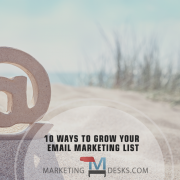Top 10 Types of Corporate Emails that Engage, Nurture and Convert
Unless you’re using all of these types of corporate emails, you could be missing out on engagement with up to 99% of your audience.
Increase Email Marketing Effectiveness with these 10 Types of Corporate Emails
Assuming direct mail response rates hold true across mail delivery methods, only about 1 to 2 percent of your network is ready to convert. The rest – the 99% – need to be nurtured and email blasts are not the way to go. Here are ten types of corporate emails you can use to increase open rates, engagement, nurture relationships, and move your contacts toward conversion.
1. Audience Interest
If up to 99 percent of your contact list is not ready to buy, the core goal for your email marketing should be engagement, and so audience interest corporate emails should make up the bulk of what you send. These are emails with content that is likely to interest your target audience overall as well as specific segments of your contact lists.
Audience interest emails include topic-related subject lines with a primary goal of getting the recipient to actually open the email (if you can’t get the email opened, every other goal you had is impossible!) If you’re active in publishing audience interest content to your corporate blog on a weekly (or even daily) basis, you’ll have a ready supply of topical content to re-purpose in your corporate emails.
Driving web traffic is often the second most important goals in audience interest email marketing. When readers click on links that interest them, you then have the ability to introduce your company or talk about your organization’s products or services as it relates to the content topic. You can also then “cookie” these site visitors so that your display advertising reminds them about your company when they’re visiting other sites (other sites that feature AdWords and other display advertising).
2. Something Old
Examples of “something old” corporate emails include communicating about closeouts and expiring offers, reminding your audience members about best sellers, sending reminders about items site visitors may have left unpurchased in their carts, and putting the spotlight on oldies-but-goodies – your company’s best-selling products and services.
3. Something New
“Something new” emails include subscriber and customer welcomes, new product or service introductions, and information about new procedures and programs – any changes your organization is making that potentially impacts your customers and prospects.
4. Something Borrowed
You can borrow both content and contacts with collaborative emails. These are cooperative marketing efforts where you’re co-marketing with another organization or you’re working in a cross-marketing arrangement.
If you’re not publishing your own original content, you can also borrow and curate content that has been published elsewhere. While you aren’t getting the direct benefit of web traffic, you’re still providing value to your audience in an expert role, increasing brand awareness and keeping your business top-of-mind.
5. Auto Response Corporate Emails
There are many times you have the opportunity to set up auto-response emails. In addition to the confirmation, thank you or other content in these emails, you can also take up real estate “below the fold” with special offers, product or service information, blog content headlines, and more, in corporate emails sent automatically for:
- Sign ups
- Orders
- Wait-list updates
- Shipping information
- Account-related updates
- Cart abandonment reminders
- Information request forms
In addition, if you’re able to identify and track site visitors, you can set up email automation which generates communication any time a site visitor takes a specific type of action. Specific site visitor activity can include buying signals, leaving signals (such as when a customer downloads all their information), and other actions.
6. Invitations and Events
Whether you’re planning to hold events online or off, you can use corporate emails to send “save the date” communications, invitations, RSVP links, reminders and post-event updates. You can also send post-event updates not just to attendees but others, giving them information about what they missed, or incentivizing future attendance by showing how valuable, fun or enjoyable the event was for attendees (make this even more powerful by including attendee testimonials!) You can also use invitation emails to let your audience members know about appearances, such as when your company plans to exhibit at a trade show or will be a featured speaker or sponsor at an important event.
7. Company News
There are many different times when sending corporate emails with company news can be interesting and engaging for your target audiences. New location openings, awards, achievements or growth benchmarks, position openings, remodels, etc., all give you a chance to let customers and prospects know why they should choose to do business with your company.
8. Calls to Action
Some percentage of your prospect and customer list is probably ready to buy! Corporate emails with calls to action delivered at the right time (often in response to buying signals or on a timeline that coincides with repeat purchase cycles) can lead to conversions or cause audience members to choose your company instead of a competitor’s.
In addition to purchase buying signals, calls to action emails can also be sent at the right time to get audience members to attend events, subscribe, enroll in special programs, sign up for wait lists and announcements, and so on.
9. Special and Limited Time Offer Corporate Emails
Closely related to calls to action emails, special offer and limited time offer emails can be sent on a regular basis that coincides with your company’s offer periods. For instance, if you run offers that are good for one week, one month, a quarter, half a year, during an introductory period, and so on.
10. Thank Yous
We’ve listed this last but it should be a top priority for your company. Sending thank you emails as part of your corporate strategy lets your customers know that you truly value their business, opinions, participation, attendance, or some other type of action.
You might also like: Infographic – Data Never Sleeps 5.0 9 Takeaways for Marketers
The more sophisticated and personalized your email approach becomes, the more effective it is likely to be. Master these ten types of corporate emails and incorporate them into your company’s communication strategy.







Trackbacks & Pingbacks
[…] the good times rolling! Staying in contact with customers after the sale using newsletters is a low cost, low pressure way to keep top of mind awareness for your brand, […]
Leave a Reply
Want to join the discussion?Feel free to contribute!